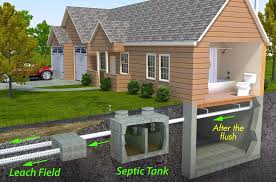
Introduction
Septic systems may not be the most glamorous topic, but they play a crucial role in safely treating and disposing of household wastewater. Understanding how septic systems work and how to properly maintain them is essential for every homeowner. In this comprehensive guide, we will cover the ABC’s of septic systems, providing you with valuable insights to ensure the longevity and efficiency of your septic system.
A – Anatomy of a Septic System
- Septic Tank: The heart of the septic system, the septic tank is a buried, watertight container made of concrete, fiberglass, or polyethylene. It collects and holds wastewater from your home, allowing solids to settle and decompose while allowing clarified water (effluent) to flow to the drain field.
- Drain Field (Leach Field): The drain field is a network of perforated pipes or chambers buried in gravel-filled trenches. It receives the effluent from the septic tank and allows it to disperse slowly into the soil, where further treatment occurs through natural processes.
- Soil: The soil beneath the drain field acts as a natural filter, removing harmful bacteria, viruses, and nutrients from the effluent as it percolates through the ground.
B – Basic Working Principle
When wastewater leaves your home through drains and toilets, it enters the septic tank. As it sits in the tank, the heavier solids settle to the bottom, forming a layer of sludge, while lighter substances float to the top, creating a layer of scum. The partially clarified water in the middle, known as effluent, exits the tank and flows into the drain field for further treatment by the soil.
C – Care and Maintenance
Proper care and maintenance are essential for the health and longevity of your septic system. Here are some crucial tips:
- Regular Pumping: Have your septic tank pumped every 3 to 5 years to remove accumulated sludge and scum. Regular pumping prevents tank overflow and costly system failures.
- Mindful Water Usage: Be mindful of water usage to avoid overloading the system. Fix leaks promptly and consider water-efficient fixtures and appliances.
- Avoid Harsh Chemicals: Avoid using excessive amounts of harsh chemicals or household cleaners. These can harm the beneficial bacteria in the septic tank, disrupting the natural decomposition process.
- Proper Waste Disposal: Never dispose of non-biodegradable items or hazardous materials down the drains or toilets. These can clog pipes and damage the septic system.
- Inspections: Schedule regular inspections by a professional to identify any issues early on. Promptly address any necessary repairs or maintenance.
- Landscaping Considerations: Avoid planting trees or shrubs with aggressive root systems near the septic system, as they can damage pipes and the drain field.

Conclusion
Understanding the ABC’s of septic systems is vital for every homeowner with a septic system. By knowing how the system works and following proper care and maintenance practices, you can ensure its efficiency and prolong its lifespan. A well-maintained septic system not only protects your property but also contributes to a healthier environment. If you have any concerns or need assistance with your septic system, don’t hesitate to reach out to a professional septic service for guidance. Taking care of your septic system today means a cleaner, safer tomorrow for your household and the community.
